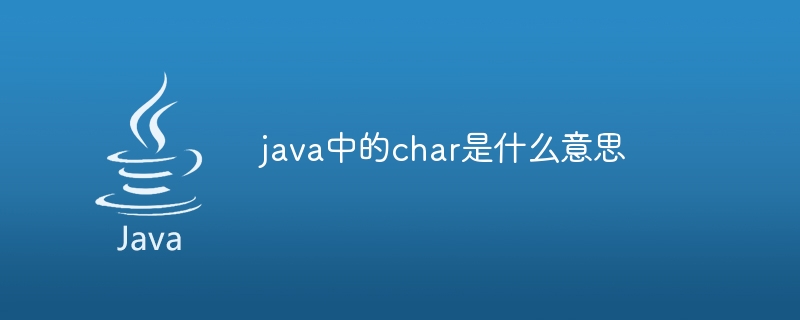What does char in java mean?
Java 中的 char 类型用于存储单个 Unicode 字符,占 2 个字节,范围从 U+0000 到 U+FFFF,主要用于存储文本字符,可以通过单引号或 Unicode 转义序列初始化,可参与比较、相等性、不相等性和连接运算,可隐式转换为 int 类型,也可以显式转换为 Character 对象。

Java 中的 char 类型
Java 中的 char 类型是一种原始数据类型,用于存储单个 Unicode 字符。它占 2 个字节,可以表示从 U+0000 到 U+FFFF 的 Unicode 字符范围。
用途
char 类型主要用于存储文本字符,例如字母、数字和符号。它常用于表示用户名、密码、文件路径和字符串中的单个字符。
范围
char 类型的最小值为 '\u0000'(NUL 字符),最大值为 '\uffff'。这意味着它可以表示 65,536 个不同的 Unicode 字符。
初始化
char 类型可以通过使用单引号将字符文字直接分配给它来初始化,例如:
char c1 = 'A';
也可以使用 Unicode 转义序列来初始化 char 类型,例如:
char c2 = '\u03B2'; // 希腊字母 β
运算
char 类型可以与其他 char 类型进行比较、相等性和不相等性运算。它还可以与字符串类型进行连接运算。
类型转换
char 类型可以隐式转换为 int 类型,因为它实际上是 16 位 Unicode 代码点。也可以使用 Character 类中的 (un)box 方法在 char 和 Character 对象之间进行显式转换。
示例
以下示例展示了如何使用 char 类型:
public class CharExample {
public static void main(String[] args) {
char c1 = 'H'; // 字符 H
char c2 = '\u0045'; // 字符 E
System.out.println("c1: " + c1);
System.out.println("c2: " + c2);
System.out.println("c1 + c2: " + (c1 + c2)); // 字符连接
}
}The above is the detailed content of What does char in java mean?. For more information, please follow other related articles on the PHP Chinese website!

Hot AI Tools

Undresser.AI Undress
AI-powered app for creating realistic nude photos

AI Clothes Remover
Online AI tool for removing clothes from photos.

Undress AI Tool
Undress images for free

Clothoff.io
AI clothes remover

Video Face Swap
Swap faces in any video effortlessly with our completely free AI face swap tool!

Hot Article

Hot Tools

Notepad++7.3.1
Easy-to-use and free code editor

SublimeText3 Chinese version
Chinese version, very easy to use

Zend Studio 13.0.1
Powerful PHP integrated development environment

Dreamweaver CS6
Visual web development tools

SublimeText3 Mac version
God-level code editing software (SublimeText3)

Hot Topics
 How to use short in java
May 07, 2024 am 03:33 AM
How to use short in java
May 07, 2024 am 03:33 AM
short is a primitive data type in Java that represents a 16-bit signed integer in the range -32,768 to 32,767. It is often used to represent small integers, such as counters or IDs, and supports basic arithmetic operations and type conversions. But since short is a signed type, you need to be careful when using division to avoid overflow or underflow.
 Usage of ifnull in sql
Apr 28, 2024 am 09:57 AM
Usage of ifnull in sql
Apr 28, 2024 am 09:57 AM
The IFNULL function checks whether an expression is NULL and returns the specified default value if so, otherwise it returns the value of the expression. It prevents null values from causing errors, allows manipulation of null values, and improves the readability of queries. Usage includes: replacing null values with default values, excluding null values from calculations, and nested usage to handle multiple null value situations.
 What does char in java mean?
May 01, 2024 pm 06:15 PM
What does char in java mean?
May 01, 2024 pm 06:15 PM
The char type in Java is used to store a single Unicode character, accounting for 2 bytes, ranging from U+0000 to U+FFFF. It is mainly used to store text characters. It can be initialized through single quotes or Unicode escape sequences, and can participate in comparison, Equality, inequality and join operations can be implicitly converted to int type or explicitly converted to Character objects.
 How to calculate division in c language
Apr 13, 2024 pm 09:12 PM
How to calculate division in c language
Apr 13, 2024 pm 09:12 PM
In C language, the behavior of the division operator / depends on the data type of the operands: Integer division: When the operand is an integer, integer division is performed and the result is rounded down. Floating point division: When the operand is a floating point number, floating point division is performed and the result is a floating point number. Type conversion: When one operand is an integer and the other is not, the integer is implicitly converted to a floating point number, and then floating point division is performed. Divisor by 0: A mathematical error occurs when the divisor is 0. Modulo operation: Use the % operator for modulo operation instead of modulo division.
 Usage of (+ in oracle
May 08, 2024 pm 08:12 PM
Usage of (+ in oracle
May 08, 2024 pm 08:12 PM
The plus (+) operator in Oracle can be used to: connect strings, numbers, dates, and time intervals; handle NULL values and convert NULL to non-NULL values; convert data types to string types.
 What does * mean in mysql
Apr 26, 2024 am 07:21 AM
What does * mean in mysql
Apr 26, 2024 am 07:21 AM
The asterisk (*) in MySQL means "all" and has different uses: Select all columns Select all rows JOIN wildcards for table LIKE clause Quantifier implicit type conversion for REGEXP clause
 Let's explore common application scenarios of implicit type conversion!
Jan 11, 2024 pm 04:45 PM
Let's explore common application scenarios of implicit type conversion!
Jan 11, 2024 pm 04:45 PM
Let’s explore common application scenarios of implicit type conversion! Introduction: In programming languages, implicit type conversion is an automatically performed data type conversion process. In some programming languages, this conversion is performed implicitly, without the need to explicitly tell the compiler or interpreter to perform the conversion. Implicit type conversion has a wide range of application scenarios in programming. This article will discuss some of the common application scenarios. Implicit type conversion in numerical calculations In numerical calculations, operations between different types of data are often required. When different types of data
 What are the matching rules for C++ function overloading?
Apr 27, 2024 am 08:27 AM
What are the matching rules for C++ function overloading?
Apr 27, 2024 am 08:27 AM
The C++ function overload matching rules are as follows: match the number and type of parameters in the call. The order of parameters must be consistent. The constness and reference modifiers must match. Default parameters can be used.






